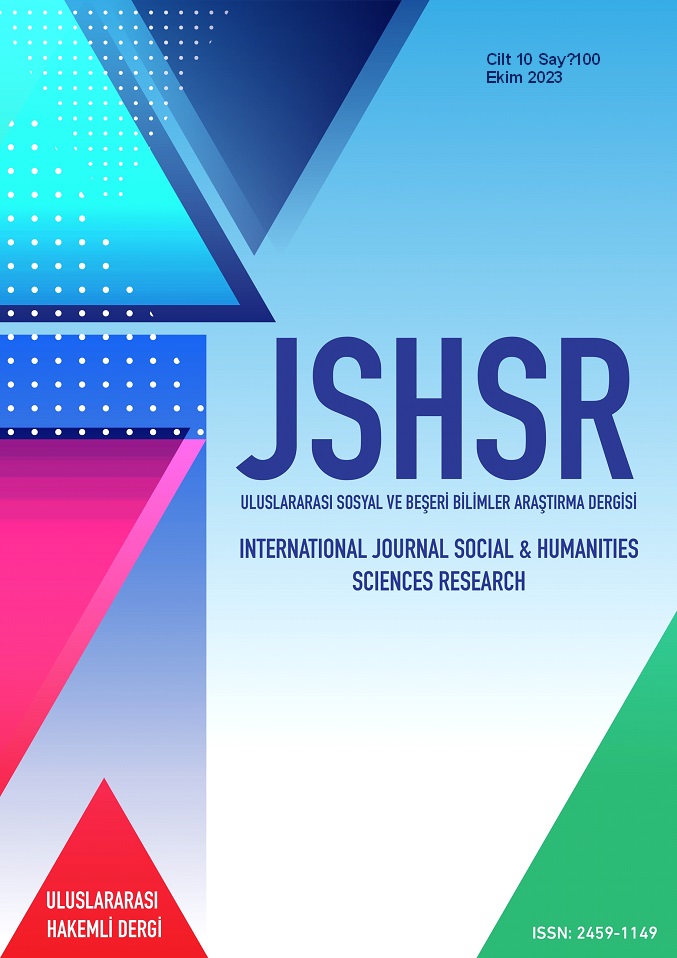Determination of Structural Features of Halays by Fieldwork
DOI:
https://doi.org/10.5281/zenodo.10028888Keywords:
Keskin, Halay, Fieldwork, Netnography, TRT Notes ArchiveAbstract
Halay, an important element of Turkish music and dance culture, is seen in a wide geography and has many different varieties. The main purpose of this study was determined as examining the structural features of halays, which are performed in an interconnected way and consist of different parts within themselves. Analyzes were made according to the rhythm, melodic and dance figures of the halays using the "netnography" method, which is defined as a fieldwork method. Based on the Keskin Halayı sample, ten halay samples selected in the Kırıkkale/Keskin, Kırşehir and Çorum axis were analyzed. As a result of the samples analyzed, the parts of Keskin Halayı, which is stated as two parts in the note in the TRT THM music archive, were determined to be at least 3 and at most 6. In the halay videos analyzed, it was observed that the figures made by the dancers changed during the transition between sections. The sections of Keskin Halayı were measured as |8:4| in the first section, |4:4| in the second section, |2:4| in the third section, |6:8| in the fourth section, and |2:4| in the fifth and sixth sections. It was observed that the Keskin Halayı, which started at a slow pace, gradually accelerated in the following sections. It has been seen that this halay is also performed in Kırşehir and Çorum cities, but some differences have been detected. Although Keskin Halayı is classified as a non-verbal dance form, it has been observed that verbal works also accompany the dance in the examples analyzed. It has been determined that there is no information in the TRT THM notes archive that these verbal works are halay. As a result of this research, it was suggested to reanalyze 71 halays that in the TRT THM non-verbal works category. Additionally, since the netnography method may be insufficient in some cases, it was also recommended to go directly to the field and conduct interviews.
References
Akdoğu, O. (2003). Türk Müziği’nde Türler ve Biçimler. Meta Basım.
Archikeskin Ugurr (2016, Aralık 25). Kırıkkale Keskin Çelebi Davul Zurna Ağırlama Halayı. [Video]. YouTube. https://www.youtube.com/watch?v=cmLw9b_CWXk
Arslan, A. (2007). İlkçağ Felsefe Tarihi 3. İstanbul Bilgi Üniversitesi Yayınları.
İsmail Babadağ. (2016, Temmuz 24). Babadağlar Halayı Keskin Karaağaç. [Video]. YouTube. https://www.youtube.com/watch?v=4RS6WevY0xw
Baştepe, K. (2018). Notaya aktarılmış Türk halk müziği eserlerinin kaynak kişi icrasına göre incelenmesi [Yayımlanmamış yüksek lisans tezi]. Kırıkkale Üniversitesi Sosyal Bilimler Enstitüsü, Kırıkkale.
Mesut Batak. (2015, Ekim 19). Çorum Sungurlu Ağırlama Halayi—2015 Ankara Çorum Tanıtım Günleri. [Video]. YouTube. https://www.youtube.com/watch?v=o4lzKV2TQD4
Boratav, P. N. (1994). 100 Soruda Türk Folkloru. Gerçek Yayınevi.
Mehmet Canberk. (2013, Şubat 15). Keskin Belediyesi Halay. [Video]. YouTube. https://www.youtube.com/watch?v=mIStKlWPS-4
Dahan, G. S., & Levi, E. (2012). Netnografya: Sosyal mecralarda tüketici araştırmaları üzerine yeni bir metot. Gümüşhane Üniversitesi İletişim Fakültesi Elektronik Dergisi, 1 (3), 33-54.
Demir, Ö. (1997). Her Yönüyle Kırıkkale. Kiktav Yayınları.
Demir, S. (2011). Türk halk müziğinde tür meselesi [Yayımlanmamış Doktora Tezi]. Sakarya Üniversitesi, Sosyal Bilimler Enstitüsü, Sakarya.
Duygulu, M. (2014). Türk Halk Müziği Sözlüğü. Pan Yayıncılık.
Eyuboğlu, İ. Z. (1991). Türk Dilinin Etimoloji Sözlüğü. Sosyal Yayınlar.
Mehmet Gencay. (2016, Aralık 13). Keski̇n Halay Eki̇bi̇. [Video]. YouTube. https://www.youtube.com/watch?v=L98XtPcTKKw
Jupp, V. (2006). The Sage Dictionary of Social Research. Sage.
Karahasanoğlu, S., & Yavuz, E. D. (2018). Müzikte Araştırma Yöntemleri. Berceste Yayınevi.
Karasar, N. (2017). Bilimsel İrade Algı Çerçevesi ile Bilimsel Araştırma Yöntemi: Kavramlar İlkeler Teknikler. Nobel Akademi Yayıncılık.
Keskin Çalış Köyü Halayları. (2018, Ekim 26). Keskin Çalış Köyü #ağırlamahalayı. [Video]. YouTube. https://www.youtube.com/watch?v=M1iLiEqP-0c
Keskin Kaymakamlığı. (t.y.). İlçemizin Tarihçesi. http://www.keskin.gov.tr/ilce-tarihce
Mehmet Koylu. (2014, Mayıs 30). Çorum Ağırlaması (Arifegazili). [Video]. YouTube. https://www.youtube.com/watch?v=tUcQV3K3fm4
Kültür ve Turizm Bakanlığı. (t.y.). Keskin İlçesi. https://kirikkale.ktb.gov.tr/TR-172546/keskin.html
Myers, H. (1992). Ethnomusicology: An introduction. W. W. Norton & Co Inc., Macmillan.
Nettl, B. (1964). Theory and Method in Ethno-Musicology. The Free Press of Glencoe.
Taner Olgun. (2018, Mart 27). Keski̇n Mi̇lli̇ Halay Eki̇bi̇. [Video]. YouTube. https://www.youtube.com/watch?v=xnAykJfwNWc
Özbek Kamera. (2017, Eylül 8). Keskin Halayı, Halay Böyle Çekilir. [Video]. YouTube. https://www.youtube.com/watch?v=YW22bI3NQQw
Özbilgin, M. Ö. (1995). Türk halk oyunlarında tür ve biçim sorunu [Yayımlanmamış Yüksek Lisans Tezi]. Ege Üniversitesi, Sosyal Bilimler Enstitüsü, İzmir.
Parlatır, İ., Gözaydın, N., Zülfikar, H., Aksu, B., Türkmen, S., & Yılmaz, Y. (1998). Türk Dil Kurumu Türkçe sözlük (C. 2). Türk Tarih Kurumu Basım Evi.
Sachs, C. (1962). The Wellsprings of Music. The Hague: Martinus Nijhoff. Recommended Reading.
Şahin, M. (2009). Türk halk oyunları türlerine göre asma davulun incelenmesi [Yayımlanmamış Sanatta Yeterlik Tezi]. İstanbul Teknik Üniversitesi, Sosyal Bilimler Enstitüsü, İstanbul.
Aykut Şimşek. (2016, Haziran 20). Kırşehir / Akçakent / Taşoluk Köyü—Ağırlama Halay. [Video]. YouTube. https://www.youtube.com/watch?v=mNtymwEhQtg
Turan, Z. (2000). Türk halk oyunları türlerinden halayların yapısal özellikleri [Yayımlanmamış Yüksek Lisans Tezi]. Ege Üniversitesi, Sosyal Bilimler Enstitüsü, İzmir.
Uyanık, M. (2012). Tümevarım meselesi: İbn Sînâ merkezli yeni bir okuma. Hitit Üniversitesi İlahiyat Fakültesi Dergisi, 11 (21), 195-230.
Vikipedi. (t.y.). Keskin. https://tr.wikipedia.org/w/index.php?title=Keskin&oldid=28300345
Downloads
Published
How to Cite
Issue
Section
License
Copyright (c) 2023 INTERNATIONAL JOURNAL OF SOCIAL HUMANITIES SCIENCES RESEARCH

This work is licensed under a Creative Commons Attribution 4.0 International License.


